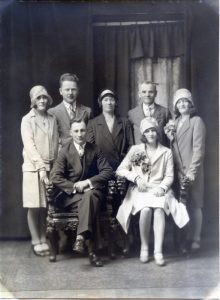The Burning of the Houses
Michael Pregnar [3715]
was the youngest son of
Theodorus Pregnar [1040] of
House 40 in Rozdziele.
He died on November 4, 1872 at the age of 20.
Michael's cause of death on his
death record
is noteworthy:
Tempore incendis domus - ipse vitam amisit
Clearly his death had something to do with a house fire (incendis domus), but the Latin grammar is worth examining.
incendis must be the ablative plural ("by means of the burnings"). And domus ("house"), in this context, cannot be the nominative case; it has to be the genetive plural. That means that there was a fire in which more than one house burned down: literally, "by means of (or because of or from) the burning of the houses".
The word Tempore is also significant: "in time". That seems to suggest that it took a while for Michael to die, and so the fire that killed him evidently took place at some time in the past. Possibly he lingered with burn wounds for a long time.
vitam amisit means "he lost (literally put aside) his life" and it has a connotation of accident about it.
So, an idiomatic translation might be,
He lost his own life [by accident], after a while, from when the houses burned down.
That sounds like a significant event that everybody knew about and talked about: "when the houses burned down."
(I should also mention that it was highly unusual for anyone in this era to get more than a one or two words in the cause of death column. Such a long entry is significant, and indicates that the scribe thought it was significant, too.)
There is something else intriguing about
that page of death records.
No deaths at all were recorded in the village between February 1869 and March 1872! Did death take a holiday in those years?
The plot thickens. Take a look at the handwriting in this page-- it's a mess. The handwriting of the first three records is that of Reverend Andreas Kiebak, whose style I have gotten to know quite well. He's very neat and regular. He became parish priest in 1855, and he baptized and buried quite a number of my ancestors. But for the rest of the page, I can recognize two or three different scribes at work, and they make mistakes like forgetting to record the house number or forgetting to draw a line between the records. Such mistakes, while minor, are rare among the meticulous priests who took great care with these record books.
There is also a gap in the book of marriages; Rev. Kiebak performed his last wedding in November 1868 and there wasn't another one until September 1872. (see Note 12: Partial list of gaps in the records).
Most striking is that the birth records stop in May, 1870, when Rev. Kiebak performed his last baptism. There are no more birth records available until 1873, and those come from a handwritten copy; the original book of births is unavailable.
So these are the things we now know about Rozdziele in the first years of the 1870s: the village went without a priest for a period of almost two years, something happened to some of the record books, and there was a fire that engulfed multiple structures. And Michael,
the little brother of my great-great grandmother Maria Pregnar [3261],
lost his life in the burning of the houses.

